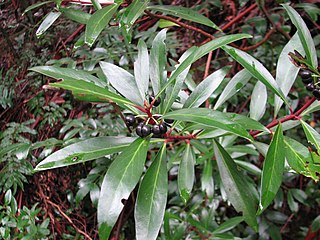
Tasmannia is a genus of about 36 species of flowering plants in the family Winteraceae, and is native to Australia and New Guinea, with one species also found in parts of Southeast Asia. Plants in the genus Tasmannia are shrubs or small trees, usually dioecious with simple leaves, mostly white, sometimes yellow flowers, and one to many clusters of berries.

Pachypodium brevicaule is a species of plant that belongs to the family Apocynaceae.

Tasmannia lanceolata, commonly known as pepper tree, native pepper, mountain pepper or mountain pepperbush, is a species of flowering plant in the family Winteraceae, and is endemic to south-eastern Australia. It is a dioecious bushy shrub to small tree with lance-shaped or narrowly ellipic leaves, male and female flowers on separate plants, the flowers with 3 to 9 petals, and the fruit a deep maroon to glossy black berry.
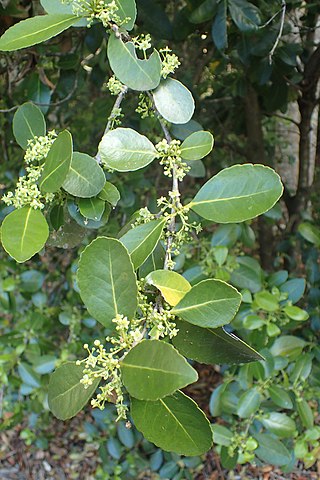
Elaeodendron australe, commonly known as red olive-berry, red-fruited olive plum, or blush boxwood, is a species of flowering plant in the family Celastraceae and is endemic to eastern Australia. It is a shrub or small tree with egg-shaped to oblong leaves with a wavy margin, yellowish green male and female flowers on separate plants and fleshy orange-red fruit.

Zanthoxylum brachyacanthum, known as thorny yellow-wood, satinwood, satin tree or scrub mulga, is a species of flowering plant in the family Rutaceae and is endemic to north-eastern Australia. It is a rainforest shrub or tree with thick, cone-shaped spines on the trunk and prickles on the branches, pinnate leaves, and male and female flowers arranged in panicles.

Tasmannia purpurascens, commonly known as the broad-leaved pepperbush, is a shrub in the primitive family Winteraceae and is only found growing in the Barrington Tops and Ben Halls Gap regions of New South Wales. It is locally abundant in a restricted subalpine habitat with a high rainfall, often growing in the ecotone in association with Antarctic Beech.

Wilkiea hugeliana, commonly known as veiny wilkiea, common wilkiea or tetra beech, is a species of flowering plant in the family Monimiaceae, and is endemic to eastern Australia. It is a tall shrub or small tree with egg-shaped, oblong to narrowly elliptic leaves, and male and female flowers on separate plants. Male flowers have 3 or 4 stamens and female flowers have 20 to 40 carpels, and the fruit is a blackish oval drupe with a yellow to orange receptacle.
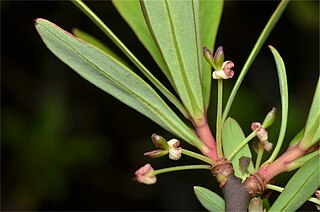
Tasmannia glaucifolia, commonly known as fragrant pepperbush, is a species of flowering plant in the family Winteraceae, and is endemic to New South Wales. It is a dioecious shrub with lance-shaped leaves, the narrower end towards the base, the flowers usually without petals, male and female flowers on separate plants and the fruit is a glossy, deep purple-black berry.
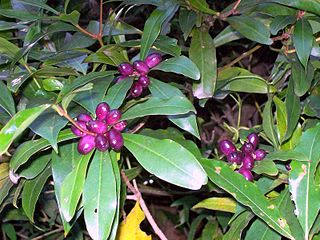
Tasmannia insipida, commonly known as brush pepperbush, Dorrigo pepper, pepper bush, pepper tree or faint pepper bush, is a species of flowering plant in the family Winteraceae, and is endemic to eastern Australia. It is a shrub or small tree with lance-shaped or egg-shaped leaves the narrower end towards the base, the flowers male and female flowers on separate plants, male flowers with 17 to 65 stamens, female flowers with a single carpel with 15-40 ovules, and the fruit a purplish berry.

Tasmannia membranea, commonly known as pepper tree, is a species of flowering plant in the family Winteraceae, and is endemic to north-eastern Queensland. It is a shrub or tree with lance-shaped or egg-shaped leaves, male and female flowers on separate plants, with two petals on each flower. The male flowers have 30 to 62 stamens, and the female flowers have a single carpel with 14 to 36 ovules, and the fruit is black.

Grevillea shiressii is a species of flowering plant in the family Proteaceae and is endemic to New South Wales where it is found in only two localities near Gosford. It is an erect shrub with oblong to narrowly lance-shaped and small clusters of green to bluish-grey, later cream-coloured flowers with a brownish-maroon style.

Acronychia octandra, commonly known as doughwood, silver birch or soapwood, is a species of rainforest tree that is endemic to eastern coastal areas of Australia. It has mostly trifoliate leaves with elliptic to egg-shaped leaflets, greenish-white flowers arranged in groups in leaf axils and fleshy fruit of four carpels fused at the base.
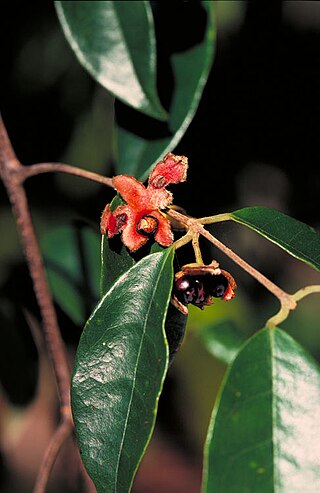
Palmeria scandens, commonly known as anchor vine or pomegranate vine, is a species of flowering plant in the family Monimiaceae and is native to Queensland, New South Wales and New Guinea. It is a woody vine with elliptic to oblong leaves and male and female flowers borne on separate plants, male flowers usually with thirty to forty stamens and female flowers with about ten carpels. The fruit is green, splitting to form a pinkish receptacle with 3 to 7 black or red drupes.
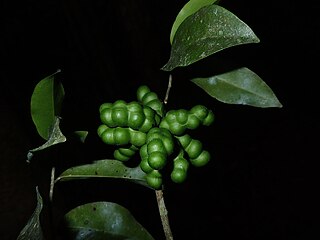
Uvariopsis congensis is a species of plant in the Annonaceae family. It is native to Angola, Cameroon, the Central African Republic, the Democratic Republic of the Congo, Gabon, Ivory Coast, Kenya, Sudan, Uganda, Zambia. Walter Robyns and Jean Ghesquière, the botanists who first formally described the species, named it after the Belgian Congo, now called the Democratic Republic of the Congo, where the specimen they examined was collected in the town of Kisantu near the Inkisi River.

Palmeria hypotephra is a species of flowering plant in the family Monimiaceae and is endemic to Queensland. It is a woody climber with elliptic to egg-shaped leaves, male and female flowers on separate plants with 4 or 5 tepals, male flowers with 30 to 35 stamens, female flowers with 10 to 12 carpels, and spherical, dark brown to black drupes.

Wilkiea angustifolia is a species of flowering plant in the family Monimiaceae, and is endemic to Queensland. It is a dioecious shrub with elliptic leaves, male and female flowers on separate plants, male flowers with 4 stamens, female flowers with 8 to 20 carpels, and the fruit a purple to black drupe.

Palmeria foremanii, commonly known as anchor vine, is a species of flowering plant in the family Monimiaceae and is endemic to an area near the New South Wales - Queensland border. It is a tall, woody climber or scrambling shrub with usually elliptic leaves, male and female flowers on separate plants with 5 tepals, male flowers with 40 to 43 stamens, female flowers with 7 to 12 carpels, and spherical, shiny black drupes.
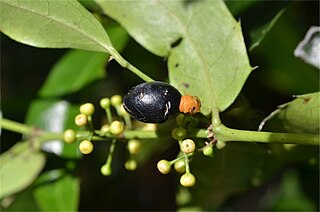
Wilkiea austroqueenslandica, commonly known as smooth wilkiea or furry-flowered wilkiea, is a species of flowering plant in the family Monimiaceae, and is endemic to eastern Australia. It is a spreading shrub or small tree with egg-shaped to elliptic leaves, male and female flowers on separate plants, male flowers with about 30 stamens, female flowers with about 35 carpels, and the fruit is a glossy, olive-black drupe with an orange fruiting receptacle.
Wilkiea cordata is a species of flowering plant in the family Monimiaceae, and is endemic to north-east Queensland. It is a shrub or small tree with oblong leaves, male and female flowers on separate plants, male flowers with stamens in 2 pairs, female flowers with about 25 carpels, and the fruit is an oval drupe with a yellow receptacle with an orange tinge.
Wilkiea hugeliana is a species of flowering plant in the family Monimiaceae, and is endemic to Cape York Peninsula in far northern Queensland. It is a shrub or small tree with elliptic, sometimes toothed leaves, and male and female flowers on separate plants. Male flowers usually have 4 pairs of stamens and female flowers have about 40 carpels, and the fruit is a glossy black drupe with enlarged orange receptacles.



















